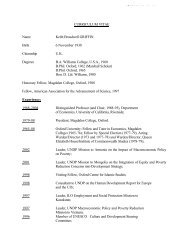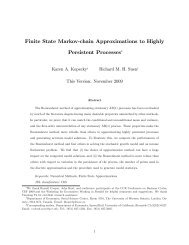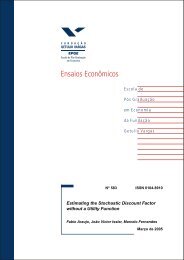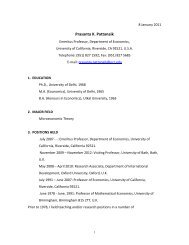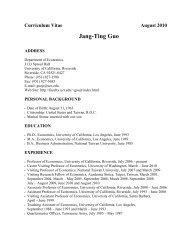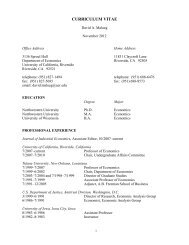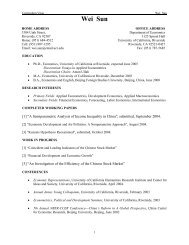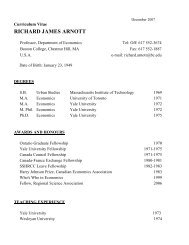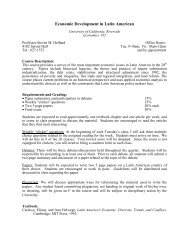Copula-based Multivariate GARCH Model with ... - Economics
Copula-based Multivariate GARCH Model with ... - Economics
Copula-based Multivariate GARCH Model with ... - Economics
You also want an ePaper? Increase the reach of your titles
YUMPU automatically turns print PDFs into web optimized ePapers that Google loves.
predicted likelihoods<br />
I R,P (ϕ : ψ 0 ) − I R,P (ϕ : ψ j )= 1 P<br />
TX<br />
t=R+1<br />
ln[ψ j t (r t; ˆβ j R)/ψ 0 t (r t ; ˆβ 0 R)]. (24)<br />
When we compare multiple l C-M<strong>GARCH</strong> models using various copulas against a benchmark<br />
M<strong>GARCH</strong> model, the null hypothesis of interest is that no C-M<strong>GARCH</strong> model is better than the<br />
benchmark M<strong>GARCH</strong>. White (2000) proposes a test statistic (so called “Reality Check”) and the<br />
bootstrap procedure to compute its p-value. 13<br />
Panel B in each of Tables 1-4 reports the density forecast comparison in terms of the OOS<br />
KLIC together <strong>with</strong> the Reality Check p-values. For OOS forecasting for P = 251 days (from<br />
Jan/05/1997 to Dec/31/1997), we report the OOS average of the predicted log-likelihood<br />
1<br />
P<br />
TX<br />
t=R+1<br />
ln ψ t (r t ; ˆβ R ) ≡ 1 P<br />
TX<br />
t=R+1<br />
ln f 123<br />
³<br />
η t ; ˆθ R´<br />
+ 1 P<br />
TX<br />
t=R+1<br />
¯<br />
ln ¯Σ 1/2 (ˆθ R )H −1/2<br />
t (ˆα R ) ¯ ,<br />
which is reported under “logL” in Panel B. In addition, we also report the OOS standard deviation<br />
of the predicted log-likelihood, which is reported under “std(logL)”.<br />
In general, the in-sample<br />
results in Panel A and the OOS results in Panel B are consistent, in that the in-sample ranking<br />
across the C-M<strong>GARCH</strong> models is generally carried over to the OOS predictive ranking of the<br />
models.<br />
For bivariate pairs of FF-DM, DM-IL, FF-IL, the density forecast comparison confirms the nonnormality.<br />
For all three families (DCC, VC, BEKK), the independent copula yields the smallest<br />
(worst) predictive likelihood. For FF-DM, Table 1B shows the predictive superiority of C-M<strong>GARCH</strong><br />
models <strong>based</strong> on Gumbel Survival copula over the M<strong>GARCH</strong> model <strong>with</strong> the bivariate normal<br />
distribution is significant (<strong>with</strong> Reality Check p-values 0.000, 0.000, 0.001, respectively for DCC,<br />
VC, SBEKK families). For DM-IL (Table 2B), the best density forecast copula function is Gumbel<br />
13 For Reality Check test in our paper, it may worth making the following two remarks on the parameter estimation<br />
uncertainty and the nestedness problem: (1) In general, the distribution of test statistic may be rather complicated<br />
because it depends on parameter estimation uncertainty (West, 1996). However, we note that one of the significant<br />
merits of using the KLIC as a loss function in comparing density forecast models is that parameter estimation<br />
uncertainty does not affect asymptotic inference. This is due to the use of the same objective function for the insample<br />
parameter estimation (minimizing the KLIC to get ˆβ R ) and for the out-of-sample forecast validation (using<br />
the KLIC as a forecast evaluation criterion). See West (1996) and Bao et al (2006) for more details. (2) While<br />
the Reality Check permits some of the competiting C-M<strong>GARCH</strong> models to nest the benchmark, it requires that<br />
at least one of them not nest the benchmark (White 2000, p. 1105-1106). In our case, some C-M<strong>GARCH</strong> models<br />
nest the benchmark when the parameter space includes the value of θ to make a copula independent. For example,<br />
Gumbel-M<strong>GARCH</strong> <strong>with</strong> θ =1makes M<strong>GARCH</strong>. But Clayton-M<strong>GARCH</strong> and Frank-M<strong>GARCH</strong> do not nest the<br />
benchmark as the parameter space of θ does not make them independent. In addition, treating the test conditional<br />
on the estimated parameter values ˆθ j R in line <strong>with</strong> Giacomini and White (2006), the OOS reality check inference may<br />
handle the nested cases as well.<br />
18




